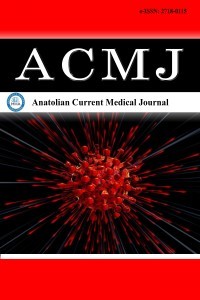
Anatolian Current Medical Journal
Yazarlar: Müslüm SAĞIR, Mustafa KAPLAN, Alpaslan TANOĞLU, Fevzi DEMİREL
Konular:Sağlık Bilimleri ve Hizmetleri
DOI:10.38053/acmj.901628
Anahtar Kelimeler:Vitamin D deficiency,Critically ill,Intensive care unit
Özet: Introduction: Vitamin D have a pivotal role in bone metabolism. It regulates immunity and inflammation. In this current research, it was aimed to determine whether there is an association between the mortality rate and the vitamin D level of critically ill patients who were followed in intensive care unit (ICU). Material and Methods: Fifty two patients (30 (58%) female and 22 (42%) male) admitted to ICU with the diagnosis of respiratory failure, sepsis, acute renal failure, multiple organ failure, GIS bleeding were included in the study. During the admission to the ICU, all of the patients’ complete blood count, C-reactive protein, serum calcium, albumin, urea, creatinine, 25-OH vitamin D, potassium, and arterial/venous blood gas levels were measured. Their acceptable mortality risk was calculated according to the APACHE II scoring system. Results: The level of vitamin D was found at least 1 up to 78.6 range, and the average was 19.61 ng/dl. Eighteen (35%) patients were discharged and 34 (65%) of the ICU patients were died. Vitamin D deficiency was observed to be a very common issue in our critically ill patients (65.4%). The difference between the two groups of age, accepted mortality and urea levels were found to be statistically significant (p<0.05). According to the terms of the patient's vitamin D status, differences were not significant (p=0.269). Vitamin D deficiency in the multivariate analysis was not an independent risk factor for mortality. Discussion: Vitamin D deficiency occurs quite often in patients with chronic, severe disease. These patients are admitted to the ICU with more serious acute problems. They have high Apache II scores as well as poor prognosis and high mortality rates during ICU. Our results suggest that although vitamin D deficiency is not a real risk factor, it is a supporting factor in explaining increased mortality rates.
Dergi editörleri editör girişini kullanarak sisteme giriş yapabilirler. Editör girişi için tıklayınız.